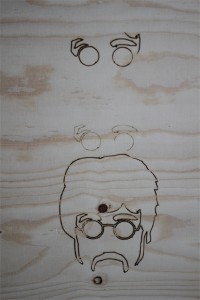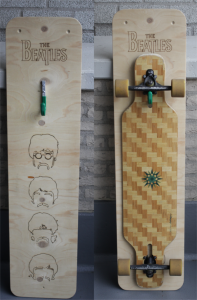The base for this project is a piece of furniture, designed to contain and display a longboard on a wall. Since a single hook would be sufficient but not protecting the wallpaper behind the longboard against scratches of its griptape, a wooden board was added. This construction is sufficient but not very appealing.
Therefore, several patterns and layouts were designed, that use the wooden board as a canvas, working as decoration when the board is taken away. The layouts focussed on lines in order to be processible by a lasercutter to be burned in. The complexity and thickness of the lines were of major importance since it would affect the processing time of the lasercutter. Hairlines could be followed by the cutter with a single stroke whereas thicker lines would require a raster approach to “fill” the lines.
During the test run on the backside, the lasercutter carried the engraving lense but was focussed for cutting. What started as an accident turned out to be the solution for engraving thick, visible lines without a rastering approach, saving time and effort. The end result was satisfying and engraved within 2 minutes after two full runs. However, the setting of the lase rcutter turned out to be too unfocussed to penetrate the surface of branch cores, which are usually harder than the surrounding wood. Nevertheless, the lines are visible and add a nice touch to the boar display.
Testcut with visible difference of in-focus and out-of-focus of the engraving.
End result without and with board in place.
File for lasercutter. The green block functioned as a placeholder for the hook.








